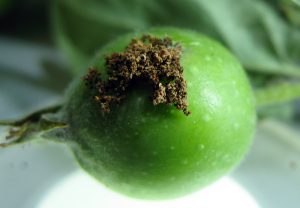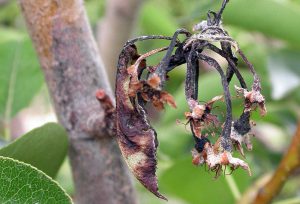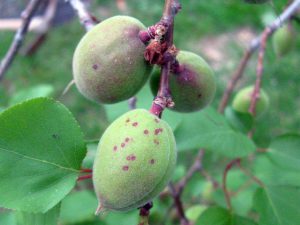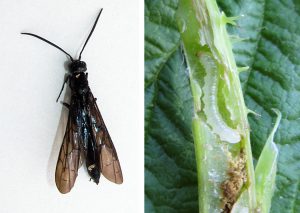In this Issue
- Codling moth: spray dates provided for first generation
- Fire blight: high risk for infection of open flowers through May 10
- Coryneum blight: treat with fungicide before or after 4-hr rain event
- Raspberry horntail: treat in mid to late May
APPLE, PEAR
Codling Moth
View a pdf of the spray timing table. Be sure to read the instructions at the top of the page, for how to read the table.

Codling moth treatment timing is coming up in mid-May for many areas of northern Utah. We will provide information about the cooler areas toward the end of next week.
So get ready, because this is a pest that you need to prevent all season long for clean fruit. Whether you are growing organic or conventional, the only non-spray option for clean fruit is to bag them (click here and here for more info on bagging fruit.)
Treatment:
Spray options for commercial growers.
The table below provides some options for backyard trees. It is important to know how long your spray application will last. For the product you are using, check the “active ingredients” listed in small print on the lower right or left of the front label. Sometimes there are several ingredients, sometimes, just one. Some materials last longer than others, and the time between sprays is not always listed on the label.
| Product Name | Efficacy | Residual Length (days) | Comments |
|---|---|---|---|
| CONVENTIONAL | |||
| Spectracide Triazicide (gamma-cyhalothrin) | Good to Excellent | 14-17 | wait 21 days to harvest |
| Monterey Bug Buster 11 (esfenvalerate) | Good to Excellent | 14-17 | wait 21 days to harvest |
| Bonide Fruit Tree & Plant Guard (lambda-cyhalothrin) | Good to Excellent | 14-17 | wait 21 days to harvest |
| Bonide Malathion; Hi Yield Malathion | Good | 5-7 | max 2 applications; some products are pears only |
| GardenTech Sevin (zeta-cypermethrin) | Good to Excellent | 14-17 | wait 14 days to harvest |
| ORGANIC | |||
| AzaSol, EcoGarden (azadirachtin) | Good | 7-10 | purchase online |
| Cyd-X (codling moth virus) | Good (if populations are low) | 7 | works best when used at beginning of generation; expensive and purchase online |
| oil such as All Seasons Oil, EcoSmart, Neem oil | Good on eggs only | 3 | recommended for first application of the generation only |
| Ortho Fruit Spray; Fertilome Fruit Tree Spray; Safer End All; Bonide Orchard Spray (all contain pyrethrin) | Good | 3-5 | |
| Monterey / Fertilome Spinosad; Captain Jack's Deadbug Brew; Natural Guard (all contain spinosad) | Good | 10 | max 6 applications per season; if applying to peach or cherry, can re-apply after 7 days |
Fire Blight

The risk for fire blight infections is HIGH to EXTREME for most locations in northern Utah. This is only a concern if there are still any open blossoms on apple or pear. The late flowers are often the most “dangerous” because we forget about them.
Spray options for commercial growers: In areas of streptomycin resistance, the use of Kasumin plus a half-rate of Mycoshield provides excellent control.
For backyard growers, you can purchase “Fire Blight Spray” or “Streptomycin Spray” at local garden centers.
PEACH/NECTARINE, APRICOT
Coryneum Blight
Prevent new infections by applying a fungicide before or right after a 4-hr rainfall.

The cool spring rains have resulted in coryneum blight infections in many areas. These existing infections will contribute to the spread of new infections on leaves and fruit. When temperatures are warm (above 75), all that is needed is 4 to 6 hours of rain to cause new infections.
There is nothing to be done about existing infections. But future infections can be prevented with a fungicide spray.
Products for commercial growers.
For backyard growers, Captan is only effective when applied before a rain. Spectracide Immunox can be applied before or after a rain, but when applied after rain, it may not provide complete protection from infection.
SMALL FRUITS
Raspberry Horntail
If raspberry horntail has been a problem, treat for adults between May 18 and May 25 for areas along the Wasatch Front.

Raspberry horntail is a sawfly that lays eggs in canes. The eggs hatch into larvae that then feed inside the upper canes, causing the tops to wilt and die. Adult horntails will soon begin emerging from canes that were infested last year, towards mid May.
If raspberry horntail is a problem in your area, an insecticide application to prevent egg-laying should go on May 18-25 for areas along the Wasatch Front (one week later in cooler areas).
Synthetic pyrethroids (or the organic, pyrethrin) and Sevin are effective. Spinosad is another option, but unproven. A second application should be applied 10-14 days later, depending on product residual and when bloom time is projected to begin. Avoid treating during bloom.
